Case Study: AAPlasma
by Matt Bell
April 28, 2021
by Matt Bell
April 28, 2021
The shortage of personal protective equipment (PPE) amidst the COVID-19 pandemic has created an ongoing concern for medical and emergency response personnel. The Centers for Disease Control and Prevention (CDC) encourages conservation strategies to help prolong supplies of PPE.1 Obtaining the needed PPE can be particularly challenging for smaller medical facilities that are competing with large hospitals for supplies. N95 respirators that health workers have depended upon for years are specifically in demand and in short supply.
One forward-thinking scientist, Greg Fridman, PhD, CEO of AAPlasma, working in tandem with NextFab, has pioneered a solution. The team has created a compact cold plasma PPE bioburden reduction device that can rapidly sanitize N95 respirators—on-site, on-demand, and in minutes.
Even more remarkable, Fridman and NextFab—with funding awarded by US Defense Logistics Agency (DLA) Research and Development and with support from Drexel University and other partners—moved from initial ideation of the device to the manufacturing of 100 Beta prototypes for front line healthcare facilities in a whirlwind 45 days, despite pandemic-driven challenges. These Beta prototypes, with design refinements from initial prototype testing, are durable, reliable, and safe for use and testing in unsupervised settings.
When COVID-19 hit the United States, plasma bioengineer Fridman was in the process of working with the US Defense Logistics Agency (DLA) and two large producers of fresh produce in the US to create a large-scale system that used Fridman’s cold plasma oxidizing technology to sanitize fresh fruits and vegetables during transport.
Both Fridman and the DLA quickly recognized the potential to adapt this technology for PPE for healthcare workers and first response teams. After an initial request from the DLA, Fridman originally proposed building 10 prototype PPE machines in three months. DLA countered, requesting 100 devices in half the time—45 days.
NextFab—Fridman’s first choice
When Fridman was asked by DLA to apply his cold plasma technology to create a device for PPE treatment within this aggressive time frame, NextFab was the only product development partner that Fridman considered. Inherent qualities like ingenuity, flexibility, and the extensive experience of team members, as well as access to NextFab’s equipment and facilities, made a partnership appealing.
While Fridman already had a relationship with NextFab, the two had never tackled anything of this scale together. However, Fridman was confident in NextFab’s product design and manufacturing capabilities. “I knew they would be able to help me build these machines.” He adds, “I’m a plasma engineer, so I had that part covered, but I needed the help of NextFab’s mechanical and electrical engineers and product designers.”
Dr. Fridman provided the plasma technology; DLA provided the funding; and NextFab provided the people, knowledge, and product design expertise.
He adds that although he had confidence his plasma technology would work, it took trust in NextFab to pursue this project. “One of qualities I admire most about NextFab is their fearlessness and optimism,” says Fridman, explaining why he had this trust. “Although the team had never done a project like this before, they moved forward with confidence.”
Matt Bell , Director of Contract Services at NextFab, adds that this confidence comes from the team understanding how to take informed risks. “We know that we don’t have all the answers at the start of a project. We start with what we do know and learn as we design, build, and iterate,” he explains. “So instead of thinking about the chasm between where we are now and where we want to go, we focus on addressing each individual challenge and then making decisions based on the latest information to take the next step forward.”
Leveraging their diverse experience in product design, engineering, and scientific knowledge, Fridman and NextFab worked together to design, prototype, and manufacture 100 prototype plasma-driven bioburden reduction machines for medical and frontline professionals to use on-site.
The Goal: 100 units in 45 days
Start date: April 9, 2020
End date: June 30, 2020
We hit the ground running… “When Greg Fridman came to us, he already had a strong concept of how he saw the product working,” explains Matt Starfield, NextFab’s Senior Electrical Engineer for Product Development. This included a block diagram detailing the functions he needed in the device. The NextFab team was able to focus on the design and prototyping stage of development rather than early-stage ideation or market and user research that Fridman had already completed.
“Our objective was to take Dr. Fridman’s novel technology and implement it into a format that could be quickly deployed and tested in the real world,” adds Walt Barger, the Senior Product Development Engineer and project lead for this device. To accomplish this, the team needed to integrate various elements of the system together, develop custom electronics and firmware, and package it all into a product that was safe, intuitive, and reliable to use.
Working within a pandemic environment required flexibility.
“This was our first project with everyone working from home,” says Barger. “We were able to work through the design phase using virtual meeting and project management tools.” Starfield kept Barger consistently informed about the electrical components he was selecting so Barger could model and determine the mechanical fit. The team was also able to keep Fridman updated on progress by sending design concepts from SolidWorks as eDrawings files, which Fridman could view, rotate, and explore using his cell phone or laptop.
While working from home during the pandemic, Barger admits that he took over his wife’s kitchen for the duration of the project to experiment with nebulizers and components that generated mist and moisture. Due to the essential nature of this PPE-related project, NextFab received special authorization from the State of Pennsylvania that permitted the team to operate at the company’s Washington Avenue facility. This enabled team members to perform tasks that needed specialized tools as the project progressed.
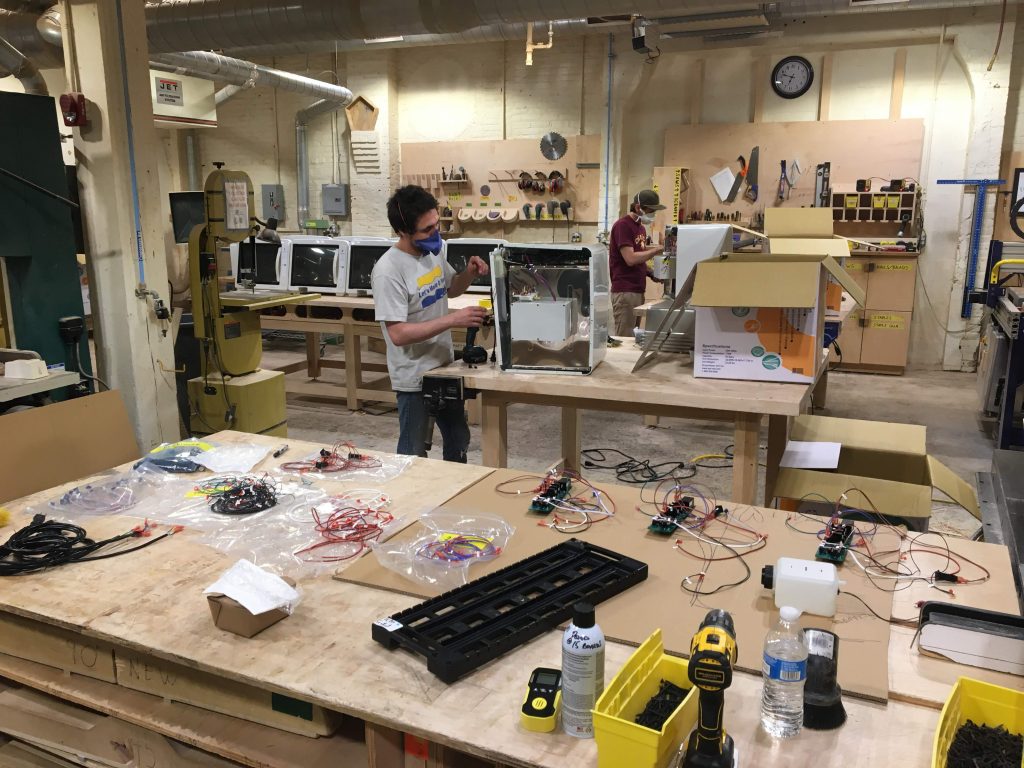
Meeting the needs of an accelerated time frame necessitated a creative approach.
“When you have 45 days to produce 100 units, updates happen in a matter of hours,” says Fridman. The speed at which each task needed to be done was a top priority and dictated prompt, but informed, project decisions, according to Matt Bell, NextFab’s Director of Contract Services.
The team needed to both design and build with tight deadlines in mind. “We had a little more than a month to not only finalize our design, but also to manufacture the products to deliver,” says Starfield, who jokingly compared the project to “re-designing an airplane while in the air.” Even though the timeline was accelerated, NextFab was able to rely on their established product development process to help the team and the project remain on track.
The time frame necessitated team members design various parts concurrently. Once a component was tested and verified, it was finalized so that any related parts could be developed for the team to deliver on time, according to Starfield. This meant any changes to the design could have a cascading impact on other parts of the system.
“This was where our solid modeling at the beginning was essential,” adds Barger. “During early discussions, we built the machine in SolidWorks using multiple configurations. So, by the time we were actually making the hardware, we knew where we were heading and had a high level of confidence in the fit.”
Dealing with supply chain delays led to unconventional sourcing solutions.
The COVID-19 pandemic led to numerous delays in receiving parts that were ordered, as well as supply chain and delivery issues. The team found they had to develop a few creative solutions to obtain the parts needed for the build. In some cases, the NextFab team actually ordered existing consumer products from Amazon or eBay and pulled out and re-purposed parts. “It was actually a fun challenge to figure out what we needed to do,” says Barger.
Anticipating future design refinements prompted the team to design for adaptability.
In addition to developing electrical and mechanical systems that were reliable, repeatable, and scalable for manufacturing, the team needed to create elements that were easy to modify, when necessary, without extensive redesign. This was particularly important as Fridman’s team was working in parallel on refining the operating parameters of the system. Starfield designed electronic controls that could allow Fridman to modify operation of the prototype and easily change how long a fan, ionizer, or other component operated—using a simple firmware update rather than a redesign of physical elements.
Containing oxidative reactions within the device.
Because the system’s cold plasma process generates corrosive oxidizers, that could be unhealthy if leaked, the team performed testing in NextFab’s ventilated paint booth that offered a fume extraction system. As highly concentrated oxidizer, produced in plasma, quickly corroded some of the system components, the team updated the design, replacing vulnerable parts with more ruggedized versions. Weather stripping and silicone sealant were added to the device to provide an extra measure of the reactive gas containment.
Overcoming early reliability issues.
Time pressure for the first few prototypes forced the team to use a readily available electronic development board which included a relay that they suspected might be under-specified for this application. After some intermittent failures during initial testing, the team quickly identified the questionable relay as the source of the problem. By the time this issue was identified, Starfield had already addressed it preemptively by designing a more robust, appropriately specified relay into the next iteration of the electronics.
NextFab needed to design, prototype, test, and ultimately deliver 100 units of the cold plasma personal protective equipment (PPE) bioburden reduction systems.
+ AAPlasma: Ideation and early research
+ NextFab Stage 1: Design and fabricate three initial prototypes
+ NextFab Stage 2: Update prototype design based on stakeholder feedback and test results
+ NextFab Stage 3: Manufacture 100 Beta prototypes
Stage 1: Design and fabricate three initial prototypes for immediate testing
With Fridman’s early groundwork and clear direction, the team’s initial goal was to complete three functional prototype devices for testing as soon as possible. “The labs [at Drexel] needed to start running these prototypes 24/7 to test both the results of the theory of operation as well as the reliability of the electronic and mechanical systems,” explains Starfield.
“This was a rush order, so we had to make a lot of difficult decisions quickly in order to design and deliver three initial prototypes that allowed the partners to begin antiviral and antimicrobial evaluations,” adds Fridman. “I particularly appreciated NextFab’s ability to work independently with minimal direction while staying on track.”
To meet the first deadline, the team focused on functionality. “This was a quick and dirty version of the product that hit all of the functionality marks,” says Starfield. For instance, he explains the electronics were hand-wired and mounted in an enclosure bolted to the side of the chamber. The team made plans to address both manufacturing efficiency and cost-optimization in later phases of design because of the pressing schedule requirements.
Time-saving creative solutions
“This project included a lot of professional hacking and ‘MacGyvering’ to design and deploy the devices quickly,” explains Barger. The team developed impressive workarounds to make this happen.
“We are lucky enough to have easy access to all the equipment we needed, as well as things like the paint booth, that we wouldn’t have predicted we needed,” he adds. “Our 3D printing also allowed us to pivot rapidly in the design.”
For efficiency, the team decided to begin with an off-the-shelf, countertop dish dryer appliance rather than designing and building a custom stainless-steel box. “We gained a huge head start by picking an off-the-shelf product that had a stainless-steel interior and some of the electro-mechanical components we needed,” says Barger. Modifications began with stripping unneeded components, machining holes in the back panels for new parts and replacing the base control circuit board with a new custom circuit board that Starfield designed to work with the dryer’s existing front-panel user interface. Starfield also used this circuit board to control the remaining hardware as well as new components, including an ionizer, nebulizer, and circulation fan.
“That’s where the experience and skill of the team mattered greatly. It’s one of the strengths NextFab was able to bring to the table. We were able to make those early decisions, weigh the results, and avoid rework down the line—because decisions were carefully considered and well-made,” says Barger.
“We trust one another’s expertise,” Starfield adds. “Because we all have different backgrounds, we were able to look at the project from different angles. We made a lot of pivots based on the feedback from other team members as we were progressing—before any hardware was developed.”
Within weeks, the team was able to design, develop, and manufacture three prototype systems. These were quickly delivered to Fridman’s team at Drexel University, which operates as a National Science Foundation Industry University Cooperative Research Center (NSF IUCRC). The university was able to obtain emergency permission to test the machines, despite the pandemic restrictions, explains Fridman. “IUCRC team conducted antiviral, antimicrobial, and material mask testing, even as NextFab was ramping up production for the 100 machines,” says Fridman.
“We learned a lot from creating the first three units and were able to evolve the design, even while Greg was gathering data,” explains Barger. The team continued to refine design elements as the testing labs worked. For example, the team adapted hand-wired electronics into a custom printed circuit board and optimized mechanical parts for manufacturing in larger quantities.
“Once the three prototypes were constructed, there was a ruggedization and Design for Assembly (DFA) stage to complete in order to meet the end goal—the manufacturing of 100 Beta prototype units,” Barger explains.
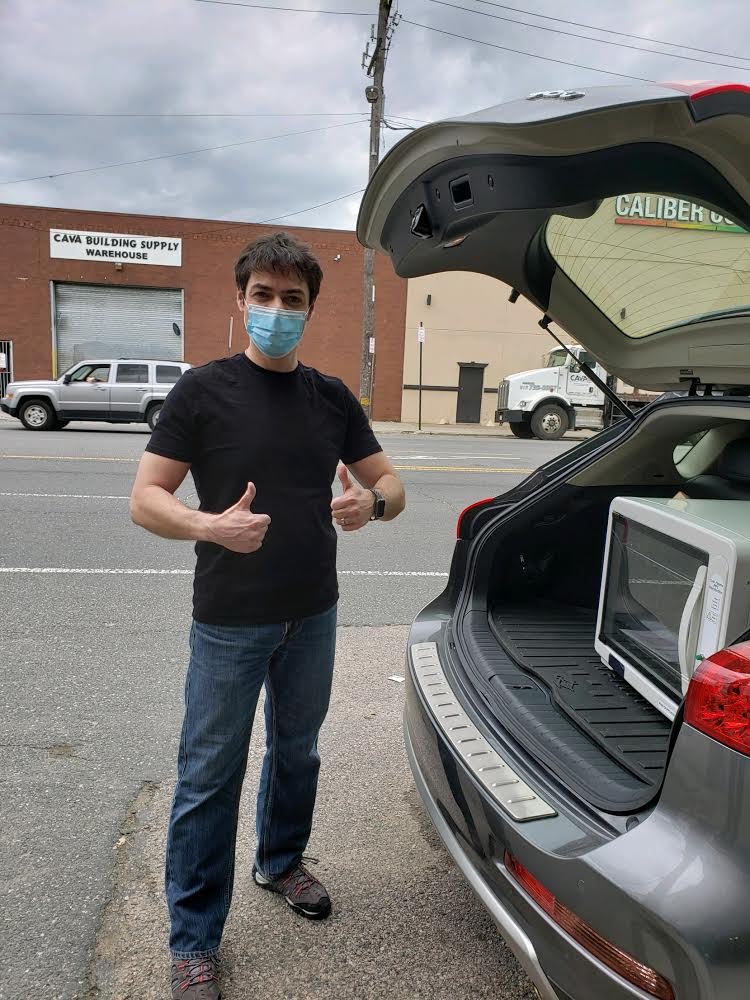
Stage 2: Update prototype design based on stakeholder feedback and test results
The NextFab team quickly moved from the original concept to an updated prototype design, based on Fridman’s feedback and test results. While testing revealed areas in need of improvement, both large and small, none slowed progress. The team quickly found solutions.
“I had confidence that if I identified a need or task, NextFab would run with it. I trusted they would be able to do what I requested and that helped facilitate the deadline and do it effectively,” shares Fridman. “We simply dealt with every problem as it arose.”
Refining the product design
When the control circuit power supply began failing due to oxidative corrosion during testing, the team resolved the problem within days by sealing the electronics with conformal coating. When the ionizer stopped functioning, Fridman realized they had to switch the fogging system to a different fluid formulation. When the fluid supply reservoir was clogging, Barger drew on basic plumbing skills from his years as a general contractor and discovered the device needed another vent.
Testing also reinforced the necessity of a few improvements the team had already performed, such as upgrading the under-specified relay on the initial development board. Other parts that were originally 3D printed were redesigned to be completed on a CNC milling machine at NextFab to speed production of the 100 units.
“I think the best thing about this project was Greg Fridman’s reaction to every update,” says Barger. “He was so enthusiastic, and it made us feel good that we were delivering what he wanted. Even when he was steering the team in a different direction, it was always with enthusiasm and passion.”
Stage 3: Manufacture 100 Beta prototypes
The 100 Beta prototype devices, designed for deployment to end-users as well as to Fridman’s manufacturing partner, Xenex Disinfection Services, were built for unsupervised use and testing with durability, reliability, and usability in mind.
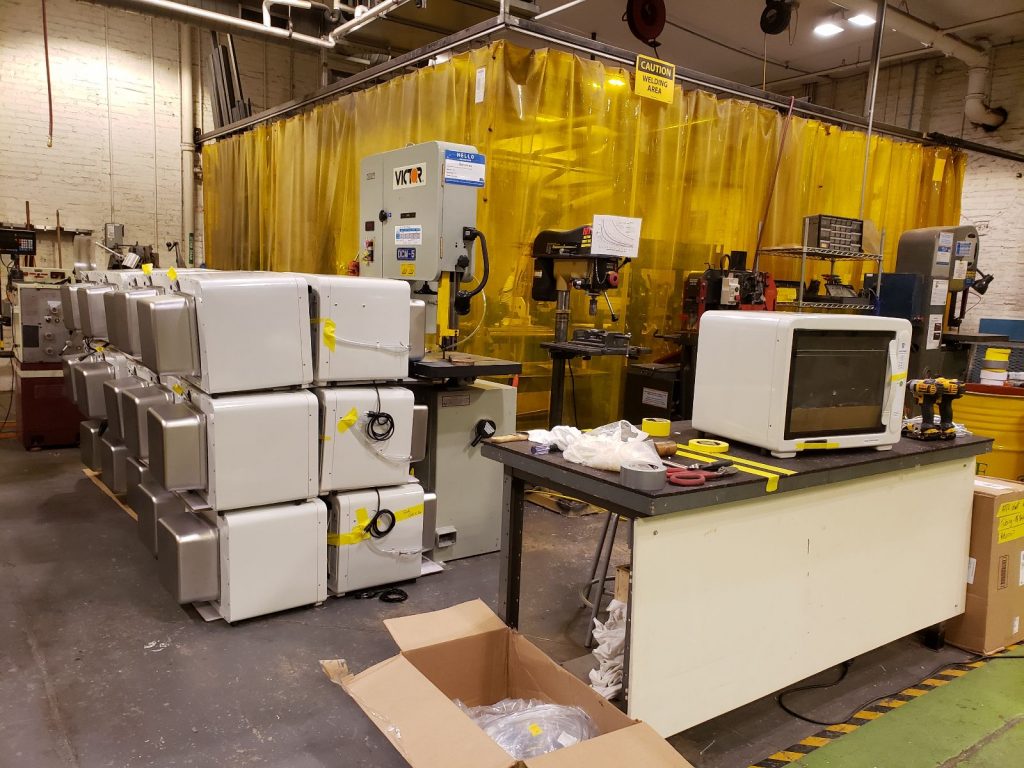
Joint focus. Shared goal.
Just as COVID-19 had created challenges, it also opened opportunities. With the shut-down of normal operations, NextFab was able to recruit help from the talented technical staff, who in normal times are focused on supervising member use of the electronics, wood, and metal shops and teaching members how to use software and equipment safely in the maker’s space lab. Pivoting from their normal duties, these individuals jumped in to help make modifications to stock components and complete this project on schedule, according to Bell. The team also divided the work between outsourcing and in-house assembly for efficiency.
“Between the equipment in our facilities and our talented, multi-disciplinary team we are uniquely suited to take on a project like this one,” says Bell. “That’s not to say it was easy. The fact that these devices could play a small part in protecting frontline healthcare workers provided more than enough motivation to push through the challenges we faced. The project was a great opportunity to take action and make a difference.” He adds, “It’s a testament to the commitment and dedication of our team.”
Starfield also points out that this joint effort and priority participation from the team was one of his favorite parts about the project. “Often, team members must switch between working on three or four projects. Seeing all of the team members contributing and working together toward a shared goal in such a short period of time was very satisfying and a point of pride,” he explains.
The development and success of this product is the result of 10,000 little, yet important, decisions made along the way. – Matt Starfield, Senior Electrical Engineer
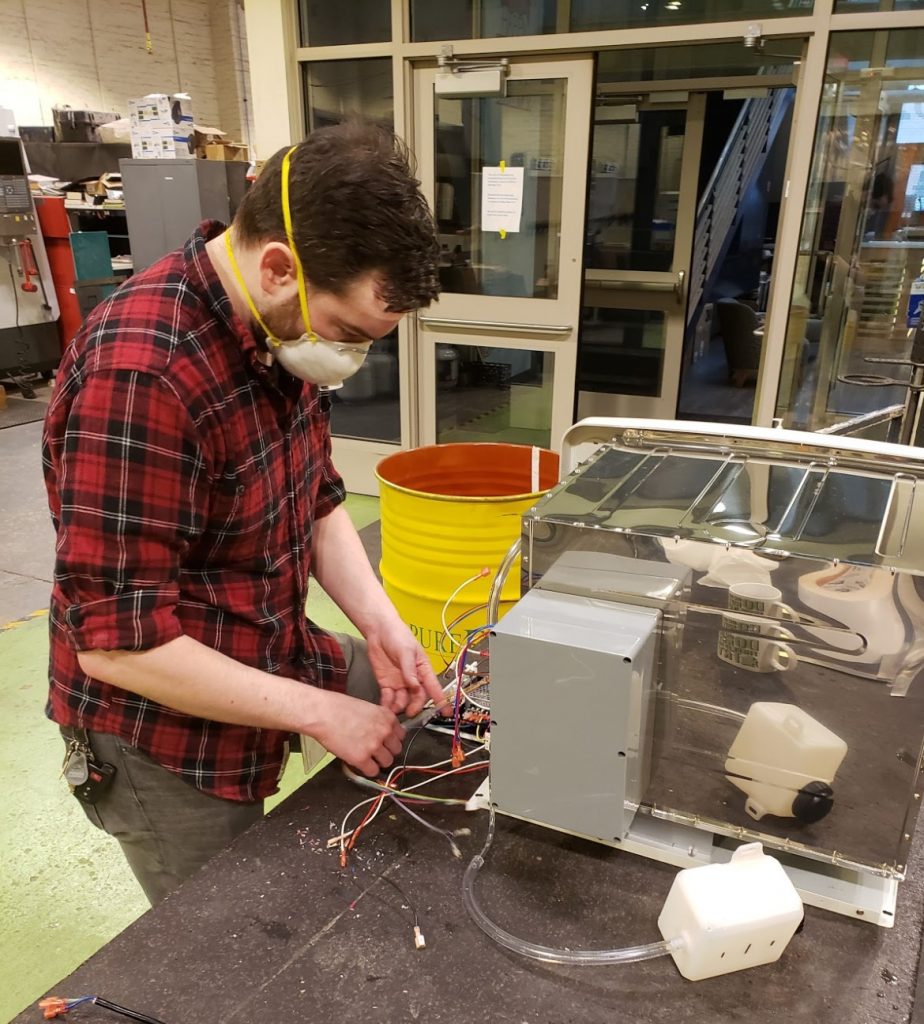
While this device is ideal for healthcare workers facing PPE shortages, it’s also suited for many environments where individuals need to reuse PPE that is not washable, such as workplaces for first responders or food processing plants.
The OxyStrike™ Bioburden Reduction System works in 20 minutes to reduce bioburden on N95 respirators—protecting against bacteria and viruses. It only requires water and electricity to operate. The compact 20-inch cube weighs less than 30 pounds and can treat up to 20 N95 respirators at a time.
The device is relatively inexpensive to manufacture and its plasma-activated fog technology is non-damaging to PPE, allowing multiple cleaning cycles (up to 20 were shown to not affect the respirator’s integrity). It’s designed for a small team or single person to use in a variety of spaces, including a medical clinic, an office, or a locker or changing room. For more information, visit https://www.oxystrike.com/.
System at a Glance
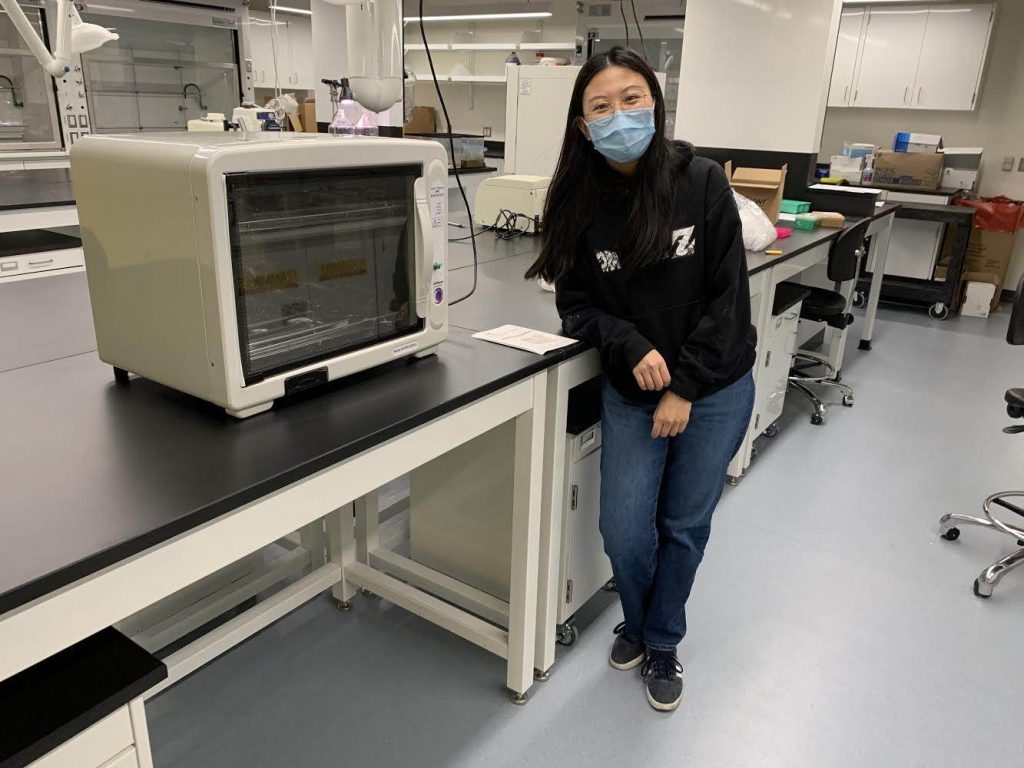
Next Steps for OxyStrike™
As soon as Fridman receives the Food and Drug Administration (FDA) Emergency Use Authorization (EUA), the 100 Beta prototypes will be distributed to partners throughout the country. Partners will receive the units for free with training and will provide regular feedback on its use. Xenex Disinfection Services, who has licensed the technology, will function as mass manufacturer and distributor for OxyStrike™ and will take ownership of the next iteration of the product.
Although the PPE bioburden reduction project has concluded, this is not the end for NextFab and Fridman. In fact, it marks another milestone in an ongoing working relationship. Fridman is already working with NextFab on his next project related to food safety.
Prior to the pandemic, Fridman explains that he was in the process of hiring engineers to grow his business. Because of the success of this PPE project, his business has pivoted and AAPlasma is now outsourcing their design and engineering efforts to NextFab.
“We look forward to continuing to support Dr. Fridman in the development of OxyStrike and other cold plasma-based products,” says Bell. “But, most importantly, we’re grateful we were able to help in developing this new device that can make a positive impact on the crises that we’re all dealing with.”
Ready to share your idea with us? Tell us a few more details.